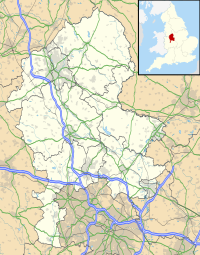
William Butterfield was a Gothic Revival architect and associated with the Oxford Movement. He is noted for his use of polychromy.

Warkworth is a village and civil parish in West Northamptonshire, about 2 miles (3 km) east of Banbury in Oxfordshire and 1 mile (1.6 km) southeast of junction 11 of the M40 motorway.

Sir Charles Archibald Nicholson, 2nd Baronet, was an English architect and designer who specialised in ecclesiastical buildings and war memorials. He carried out the refurbishments of several cathedrals, the design and build of over a dozen new churches, and the restoration of many existing, medieval parish churches.
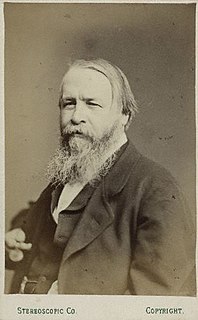
Sir Alexander James Beresford Beresford Hope PC, known as Alexander Hope until 1854, was a British author and Conservative politician.
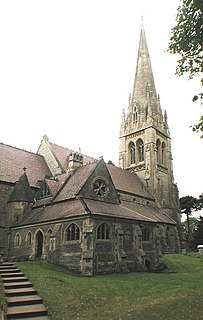
Henry Woodyer (1816–1896) was an English architect, a pupil of William Butterfield and a disciple of A. W. N. Pugin and the Ecclesiologists.

St Matthias Church is a Grade II listed Anglican church in Richmond, London. It was built in the Victorian Gothic style in 1857, and is described by Bridget Cherry and Nikolaus Pevsner as "the grandest church in Richmond". The architect was George Gilbert Scott.
George Bertram Carter was an English architect.

Christ Church on Brixton Road in Lambeth SW9 is an Art Nouveau and Byzantine Revival Grade II* listed building built in 1902 by Arthur Beresford Pite for his brother-in-law, Rev William Mowll. The foundation stone of the new church was laid on 13 December 1898 by Princess Helena, and the old church was demolished in 1899. The foundation stone, by Edward Johnston, was cut by Eric Gill in 1902. The church was consecrated by Edward Talbot, the Bishop of Rochester, on 5 December 1902. There is a prominent clock on the exterior of church, probably erected at the time of its construction. The outside pulpit in the south-west corner was designed by Weir, Burrows and Weir and was dedicated on 3 November 1907.
William Slater was an English architect who was born in Northamptonshire and practised in London. He oversaw restoration of many churches, latterly in partnership with R. H. Carpenter.

First Church of Christ, Scientist, Richmond, is a church on Sheen Road, Richmond, London. It is a branch of The First Church of Christ, Scientist in Boston, Massachusetts, founded in 1879.

Kelly & Birchall, a partnership between Edward Birchall and John Kelly (1840–1904), was an architectural practice based in Leeds, England, from 1886 to 1904 and specialising in churches in the Italianate and Gothic Revival styles.
Leslie Gooday OBE (1921–2013) was a British architect.
Captain William Charles Braxton Sinclair FRIBA was a British architect who worked in the United Kingdom and in Burma, where he was a captain in the Royal Engineers. He was also a local historian.
Bridget Cherry OBE, FSA, Hon. FRIBA is a British architectural historian who was series editor of the Pevsner Architectural Guides from 1971 until 2002. She is the co-author of several Pevsner guides.
All Saints Church, East Sheen, is a church in the London Borough of Richmond upon Thames, located at the junction of East Sheen Avenue and Park Avenue in East Sheen. All Saints Church is a member of the Anglican Communion and the Church of England and the style of worship is Modern Catholic. There are three regular Sunday services at 8:00am, 10:00am and at midday.
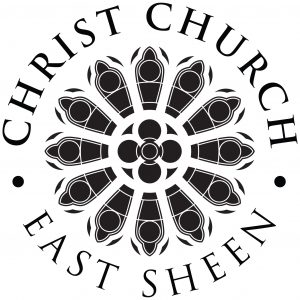
Christ Church, East Sheen, is a Church of England church on Christ Church Road, East Sheen, in the London Borough of Richmond upon Thames. Sunday services are held at 8 am and 10 am, with baptisms on the first Sunday of the month at noon. Evensong is held at 5 pm.
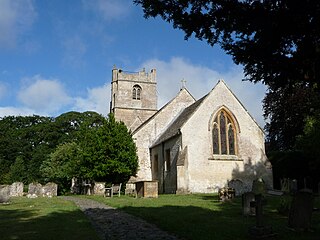
The Church of St Peter, Clyffe Pypard, Wiltshire is a parish church of the Diocese of Salisbury, England. It dates from the 13th and 15th centuries, and was restored by William Butterfield in 1860 and 1873–1874. The churchyard contains the grave of Nikolaus Pevsner and his wife Lola. St Peter's is a Grade I listed building and remains an active parish church.

Sheen is a village and civil parish in north-east Staffordshire, England.
Sheen is a civil parish in the district of Staffordshire Moorlands, Staffordshire, England. It contains 37 listed buildings that are recorded in the National Heritage List for England. Of these, four are at Grade II*, the middle of the three grades, and the others are at Grade II, the lowest grade. Apart from the village of Sheen and smaller settlements, the parish is rural. Most of the listed buildings are farmhouses and farm buildings, houses and associated structures, and cottages. The other listed buildings are a church, a memorial in the churchyard, two crosses, a road bridge, the entrance to a former country house which has been demolished, a former school, and a milepost.
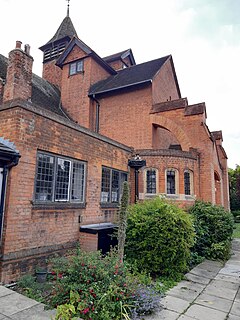
St Michael's Church, Grove Park is an Anglican church in the Grove Park district of Chiswick, opened in 1909. Its red brick architecture by W. D. Caröe & Herbert Passmore has been praised by Nikolaus Pevsner.

